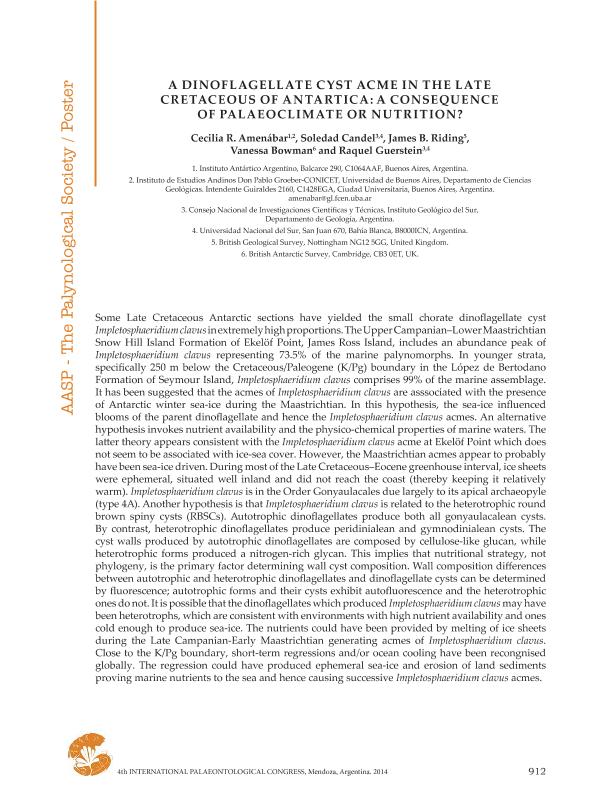Evento
A dinoflagellate cyst acme in the late Cretaceous of Antarctica: a consequence of palaeoclimate or nutrition?
Rodriguez Amenabar, Cecilia ; Candel, Maria Soledad
; Candel, Maria Soledad ; Riding, James; Bowman, Vanessa; Guerstein, Gladys Raquel
; Riding, James; Bowman, Vanessa; Guerstein, Gladys Raquel
 ; Candel, Maria Soledad
; Candel, Maria Soledad ; Riding, James; Bowman, Vanessa; Guerstein, Gladys Raquel
; Riding, James; Bowman, Vanessa; Guerstein, Gladys Raquel
Tipo del evento:
Congreso
Nombre del evento:
4th International Palaeontological Congress
Fecha del evento:
28/11/2014
Institución Organizadora:
Asociación Internacional de Paleontología;
Título del Libro:
4th International Palaeontological Congress
Editorial:
Asociación Internacional de Paleontología
Idioma:
Inglés
Clasificación temática:
Resumen
Some Late Cretaceous Antarctic sections have yielded the small chorate dinoflagellate cyst Impletosphaeridium clavus in extremely high proportions. The Upper Campanian-Lower Maastrichtian Snow Hill Island Formation of Ekelöf Point, James Ross Island, includes an abundance peak of Impletosphaeridium clavus representing 73.5% of the marine palynomorphs. In younger strata, specifically 250 m below the Cretaceous/Paleogene (K/Pg) boundary in the López de Bertodano Formation of Seymour Island, Impletosphaeridium clavus comprises 99% of the marine assemblage. It has been suggested that the acmes of Impletosphaeridium clavus are asssociated with the presence of Antarctic winter sea-ice during the Maastrichtian. In this hypothesis, the sea-ice influenced blooms of the parent dinoflagellate and hence the Impletosphaeridium clavus acmes. An alternative hypothesis invokes nutrient availability and the physico-chemical properties of marine waters. The latter theory appears consistent with the Impletosphaeridium clavus acme at Ekelöf Point which does not seem to be associated with ice-sea cover. However, the Maastrichtian acmes appear to probably have been sea-ice driven. During most of the Late Cretaceous-Eocene greenhouse interval, ice sheets were ephemeral, situated well inland and did not reach the coast (thereby keeping it relatively warm). Impletosphaeridium clavus is in the Order Gonyaulacales due largely to its apical archaeopyle (type 4A). Another hypothesis is that Impletosphaeridium clavus is related to the heterotrophic round brown spiny cysts (RBSCs). Autotrophic dinoflagellates produce both all gonyaulacalean cysts. By contrast, heterotrophic dinoflagellates produce peridinialean and gymnodinialean cysts. The cyst walls produced by autotrophic dinoflagellates are composed by cellulose-like glucan, while heterotrophic forms produced a nitrogen-rich glycan. This implies that nutritional strategy, not phylogeny, is the primary factor determining wall cyst composition. Wall composition differences between autotrophic and heterotrophic dinoflagellates and dinoflagellate cysts can be determined by fluorescence; autotrophic forms and their cysts exhibit autofluorescence and the heterotrophic ones do not. It is possible that the dinoflagellates which produced Impletosphaeridium clavus may have been heterotrophs, which are consistent with environments with high nutrient availability and ones cold enough to produce sea-ice. The nutrients could have been provided by melting of ice sheets during the Late Campanian- Early Maastrichtian generating acmes of Impletosphaeridium clavus. Close to the K/Pg boundary, short-term regressions and/or ocean cooling have been recongnised globally. The regression could have produced ephemeral sea-ice and erosion of land sediments proving marine nutrients to the sea and hence causing successive Impletosphaeridium clavus acmes.
Palabras clave:
DINOFLAGELLATE CYSTS
,
ACME
,
LATE CRETACEOUS
,
ANTARCTICA
Archivos asociados
Licencia
Identificadores
Colecciones
Eventos(CADIC)
Eventos de CENTRO AUSTRAL DE INVESTIGACIONES CIENTIFICAS
Eventos de CENTRO AUSTRAL DE INVESTIGACIONES CIENTIFICAS
Eventos(IDEAN)
Eventos de INSTITUTO DE ESTUDIOS ANDINOS "DON PABLO GROEBER"
Eventos de INSTITUTO DE ESTUDIOS ANDINOS "DON PABLO GROEBER"
Eventos(INGEOSUR)
Eventos de INST.GEOLOGICO DEL SUR
Eventos de INST.GEOLOGICO DEL SUR
Citación
A dinoflagellate cyst acme in the late Cretaceous of Antarctica: a consequence of palaeoclimate or nutrition?; 4th International Palaeontological Congress; Mendoza; Argentina; 2014; 1-1
Compartir



